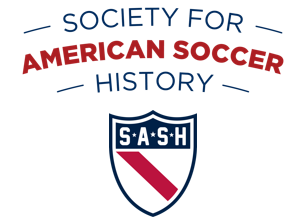The U.S. national team made its first venture into European competition in 1916, and it’s not surprising where it went. At the time of that trip, 1916, there weren’t too many options available. The United States was still a neutral in World War I at that point. So were the Scandinavian countries. All six of the United States’ games on its 1916 tour were in Sweden or Norway, although only two of them were against the national teams of those countries.
The U.S. Football Association, the same organization whose name now is the U.S. Soccer Federation, had been formed three years before and admitted to FIFA two years before, and this was the first national team that it had fielded. Its first competitive priority had been the establishment of a national cup tournament, and that had begun in the 1913-14 season. The fielding of a national team might have followed a bit more quickly but for the fact that the outbreak of World War I in the summer of 1914 suddenly made most of Europe devoid of both opponents and safe places to play. The neutral countries of Scandinavia were different (and not landlocked like Switzerland), although even that door closed in April 1917, when the United States’ neutrality ended.
Despite the fact that the trip was to last seven weeks and include six games, there were only 14 players on this United States team, which was called “The All-American Football Club.” The 14 were George Tintle and Charles Ellis from Celtic of Brooklyn; Thomas Murray and Neil Clarke from Bethlehem Steel of Bethlehem, Pa.; James Ford from Jersey AC of Jersey City, N.J.; Thomas Swords from the Fall River Rovers of Fall River, Mass.; John “Rabbit” Hemingsley from the Scots-Americans of Kearny, N.J.; Matt Diedrichsen from Innisfails of St. Louis; Harry Cooper from the Continentals of New York; Albert Blakey from Putnam of Philadelphia; James Robertson from Yonkers FC of Yonkers, N.Y.; Dick Spalding from Disston AA of Philadelphia; Clarence Smith from Babcock & Wilcox of Bayonne, N.J., and Walter Burgin from Wanderers of Philadelphia. The captain of the team was Swords. The manager was Thomas W. Cahill.
This was not the first United States team to play under the banner of being a national team. The American Football Association, which was formed in 1884, fielded teams for games against Canada in 1885 through 1888, but the AFA was a regional organization, not a national one. Of the 22 players on those 1885 and 1886 “national” teams, 20 were from New Jersey clubs and 11 were from a single club. None were born in the United States and it is questionable if any were US citizens.
The fact that the United States team made its 1916 Atlantic crossings on a neutral ship traveling between neutral countries kept it safe from U-boat attack even though this was the year after the sinking of the Lusitania. The effects of the war were not entirely invisible, however. The report printed in New York newspapers on one game in Sweden contained the notation “delayed by censors.”
Two of the games on this tour were full internationals, making the goal scored by Dick Spalding in the 22nd minute of a game against Sweden in Stockholm on Aug. 20 the first ever for the U.S. national team. Konrad Tornqvist of Sweden had opened the scoring in the seventh minute. Spalding’s goal tied the game at 1-1, and the game still was even at halftime. Early in the second half, goals by Charles Ellis and Harry Cooper put the Americans up by 3-1, although a second goal by Tornqvist narrowed the final score. The other full international on the tour was a 1-1 tie with Norway in Oslo on Sept. 3. Ellis scored the American goal in that game.
The Americans finished their tour with three wins, one loss and two ties. All three victories were by one goal, however, and the loss was a 3-0 drubbing by a combined team of Stockholm clubs AIK and Djurgardens.
A version of this article first appeared on Roger’s Big Soccer blog on July 11, 2012
